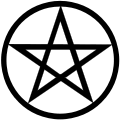Neopaganism in the United States
| Part of a series on |
| Neopaganism |
|---|
|
Related systems |
|
Similar movements |
|
Overarching organisations |
Neopaganism in the United States is represented by widely different movements and organizations. The largest Neopagan religion is Wicca, followed by Neodruidism. Both of these religions were introduced during the 1950s and 1960s from Great Britain. Germanic Neopaganism and Kemetism appeared in the US in the early 1970s. Hellenic Neopaganism appeared in the 1990s.
History
The spread of Neopaganism in the United States started in the 1960s with the introduction of Neodruidism (or Druidry) and Wicca from Great Britain. Neodruidism had begun in 1912 in the United States, but was more a fraternal order at that time.[1] Germanic Neopaganism (or Heathenism) entered during the 1970s, developing into new denominations proper to the US, notably Theodism. In the same period the first Kemetic groups were formed, with the tradition itself originating in the US.
Wicca, introduced by Gerald Gardner in 1964, is the most known of the Neopagan movements. The 1980s and 1990s saw the emergence of a number of reconstructionist and other ethnic traditions. Hellenic Neopaganism (Dodekatheism), for example, has flourished since the 1990s, along with parallel developments in Greece.
Organizations
Notable US Neopagan organizations:
- Wicca/Goddess/eclectic:
- Cherry Hill Seminary, Vermont, since 2001
- Church of All Worlds, formed 1962, formerly the largest of all the pagan movements, which centres on worship of the earth-mother goddess[2]
- Circle Sanctuary, based in Wisconsin; largest Neo-Pagan organization in the US; its newsletter, Circle Network News, has some 15,000 subscribers (as of 1992)[3]
- Council of Magickal Arts, Texas
- Covenant of the Goddess, since 1975
- Feraferia, Hellenic-inspired goddess worship, established 1967 in southern California by Frederick M. Adams, as a continuation of his Fellowship of Hesperides founded in 1957, based in Nevada City
- Feri Tradition, from ca. 1960
- First Temple of the Craft of WICA, founded February 1972
- Pagan Way, Chicago[4]
- Reclaiming Tradition, an international community of women and men working to combine earth-based spirituality and political activism
- Roman Paganism
- Nova Roma, since 1998
- Hellenic Neopaganism
- Neodruidism:
- Ár nDraíocht Féin, since 1983
- The Druid Order, since 1909
- Order of Bards, Ovates and Druids, since 1964
- Reformed Druids of North America, since 1963
- Ancient Order of Druids in America, since 1874, when it was the Ancient Archaeological Order of Druids
- Germanic neopaganism:
- Ásatrú Alliance, AA, since 1988, Arizona-based[6]
- Ásatrú Folk Assembly, AFA, California based, since 1994, re-activation of Stephen McNallen's 1974-1986 Asatru Free Assembly, formerly Viking Brotherhood, 1971-1974[7]
- Odinic Rite, ORV, "Vinland Regional Office", since 1997, Wisconsin-based[8]
- The Troth, since 1987[9]
- Wolves of Vinland
- Kemetism
- Ausar Auset Society, since 1973
- Church of the Eternal Source, since 1970
- Kemetic Orthodoxy, since 1988
- Nondenominational Pagan groups
Festivals
- Heartland Pagan Festival, since 1986
- Pagan Spirit Gathering, since 1980
- Starwood Festival, since 1981
- Pan Pagan Festival, since 1976
Demographics
Wiccan churches and other Neopagan institutions are becoming more common in the US. However, estimates of their numbers vary widely. The 2014 Pew Research Center's Religious Landscapes Survey included a subset of the New Age Spiritual Movement called "Pagan or Wiccan," reflecting that 3/4 of individuals identifying as New Age also identified as Pagan or Wiccan and placing Wiccans and Pagans at 0.3% of the total U.S. population or approximately 956,000 people of just over 1,275,000 individuals in the New Age movement.[10] Most of the 1990s studies put the number of US Neopagans between 200,000 and 1 million (0.1% to 0.5% of the total population).[11] A 2008 Pew Forum survey put "New Age" religious believers, including Neopagans, at about 1.2 million.[12]
According to David Waldron (2005),[13] roughly 10 million Wiccan-related books were sold in 2000 (up from 4.5 million in 1990), as reported by the American Booksellers Association. However this gives only a rough guide to the size of the Wiccan-related economy and he comments that the added complexity of determining the boundary between Wiccan or Neopagan products and New Age products makes determining the size of the movement from this rather problematic.
More conservative estimates included Helen Berger and Craig Hawkins in Exploring the World of Wicca, who guessed from 150,000 to 200,000. Melton, J. Gordon, Jerome Clark and Aidan A. Kelly in New Age Almanac (1991, p. 340) estimated a total of about 300,000 people associated with the "overall movement" of Wicca, with "tens of thousands" of members active in between 1,000 and 5,000 covens. Conservative estimates in 1993 arrived at about 50,000 Wiccans in the US (Religious Requirements & Practices of Certain Selected Groups: A Handbook for Chaplains, 1993) while Wiccan high estimates claimed several million (Phyllis Curott, The Book of Shadows: A Modern Woman's Journey Into the Wisdom of Witchcraft and the Magic of the Goddess). In 2008, U.S. Today estimated 1 million Wiccans,[11][14][15][16] a fast growth compared to the 100.000/200.000 estimated in late 1990s and early 2000s.[14]
Wicca

Wicca was introduced to North America in 1964 by Raymond Buckland, an expatriate Briton who visited Gardner's Isle of Man coven to gain initiation. Interest in the USA spread quickly, and while many were initiated, many more non-initiates compiled their own rituals based on published sources or their own fancy.[17] Another significant development was the creation by feminists in the late 1960s to 1970s of an eclectic movement known as Dianic Wicca, or feminist Dianic Witchcraft.
The United States Department of Veterans Affairs in an out-of-court settlement of 23 April 2007 with the family of Patrick Stewart allowed the pentacle as an "emblem of belief" on tombstones in military cemeteries.[18][19][20]
Druidry
Druidry is also known as Druidism and Neodruidism. The Ancient Order of Druids in America was founded in 1912 as the American branch of the Ancient and Archaeological Order of Druids.[21] Coming from the Druid cultural revivals in the UK in the 18th and 19th centuries, Neodruidry in the U.S. has a long history.
Celtic Reconstructionism, while not associated with Druidry directly, is also part of the cultural diaspora of Celtic Paganism. Celtic Reconstructionists place a greater emphasis on scholarly approaches, reviving and reconstructing the old practices of the Celts in the modern day.
Asatru
Ásatrú in the United States began in the early 1970s with Stephen McNallen's 1974-1986 Asatru Free Assembly, formerly Viking Brotherhood, 1971-1974.
In 1986, the "folkish vs. universalist" dispute regarding the stance of Ásatrú towards white supremacism escalated, resulting in the breakup of the Asatru Free Assembly. The "leftist" (universalist) branch reformed as The Troth, while the "rightist" (folkish) branch became the Ásatrú Alliance (AA). McNallen re-founded his own organisation as the Ásatrú Folk Assembly (AFA) in 1994.
In 1997, the Britain-based Odinic Rite (OR) founded a US chapter (ORV). This means that folkish Asatru is represented by three major organizations in the US, viz. AA, AFA and OR. The three groups have attempted to collaborate within an International Asatru-Odinic Alliance from 1997 until 2002, when it dissolved again as a result of internal factional disputes.
Discrimination
According to feminist pagan Starhawk "religious discrimination against Pagans and Wiccans and indigenous religions is omnipresent in the U.S."[22]
Controversies mostly surround religious rights in US prisons and the US military. Prison inmates' right to practice minority religions was asserted in 2004 by the Supreme Court in Cutter v. Wilkinson.
Some neopagan groups, particularly Germanic ones, have themselves been accused of racial discrimination. See Nordic racial paganism.
See also
References
- ↑ aoda.org. Ancient and Archaeological Order of Druids http://www.aoda.org/AODA_History.html. Missing or empty
|title=(help) - ↑ Encyclopædia Britannica, s.v. "Neo-Paganism
- ↑ http://www.adherents.com/Na/Na_238.html
- ↑ Aidan A. Kelly, Notes on Gardnerian History, 1963-1990, Art Magickal Publications Los Angeles, California (1994)
- ↑ http://www.hellenion.org/
- ↑ http://www.asatru.org/
- ↑ http://runestone.org/
- ↑ http://www.odinic-rite.org/contact.html
- ↑ http://www.thetroth.org/
- ↑ http://www.pewforum.org/religious-landscape-study/
- 1 2 "Adherents.com". www.adherents.com. Retrieved 2008-05-16.
- ↑ http://religions.pewforum.org/reports
- ↑ David Waldron (2005). Witchcraft for Sale!: Commodity Vs Community in the Neopagan Movement.
- 1 2 "Estimated 1 Million Wiccans in U.S. Today - Technology - redOrbit". www.redorbit.com. Retrieved 2008-05-16.
- ↑ "Major Religions Ranked by Size". www.adherents.com. Retrieved 2008-05-16.
- ↑ USA Census: Self-Described Religious Identification of Adult Population: 1990 and 2001
- ↑ Holzer, Hans (1972). The New Pagans. Garden City, NY: Doubleday. OCLC 281240.
- ↑ Associated Press (2007-04-23). "Wiccans symbols allowed on grave markers in government cemeteries". International Herald Tribune. Retrieved 2007-07-11.
- ↑ "Veterans Affairs Department Must Accommodate Wiccan Symbol On Memorial Markers At Government Cemeteries, Says Americans United" (Press release). Americans United (AU.org). 2006-06-08. Retrieved 2007-07-11.
- ↑ "Available Emblems of Belief for Placement on Government Headstones and Markers". VA.gov. Retrieved 2012-12-19.
- ↑ Ancient Order of Druids in America
- ↑ Washington Post: Discrimination Against Pagans
Further reading
- Helen A. Berger (2005-05-26). Witchcraft And Magic: Contemporary North America. ISBN 978-0-8122-3877-8.
- Helen A. Berger; Evan A. Leach; Leigh S. Shaffer (2003). Voices from the Pagan Census: A National Survey of Witches and Neo-Pagans in the United States. University of South Carolina Press. ISBN 978-1-57003-488-6.
- Helen A Berger (1999). A Community of Witches: Contemporary Neo-paganism and Witchcraft in the United States. University of South Carolina Press. ISBN 978-1-57003-246-2.
- Margot Adler (2006). Drawing Down the Moon: Witches, Druids, Goddess-Worshippers, and Other Pagans in America. Penguin Books. ISBN 978-1-101-54976-6.
- Robert S. Ellwood; Harry Baxter Partin (1988). Religious and spiritual groups in modern America. Pearson College Div.
- Annie Gottlieb (1987). Do you believe in magic?: the second coming of the sixties generation. Crown.
- Robert S. Ellwood, Notes on a Neopagan Religious Group in America, History of Religions (1971).
- J. Gordon Melton (2003). Encyclopedia of American religions. Gale / Cengage Learning. ISBN 978-0-7876-6384-1.
- G. Melton and I. Poggi, Magic, Witchcraft, and Paganism in America (1992).
- Sarah M. Pike (2004). New Age and Neopagan Religions in America. ISBN 978-0-231-12402-7.
